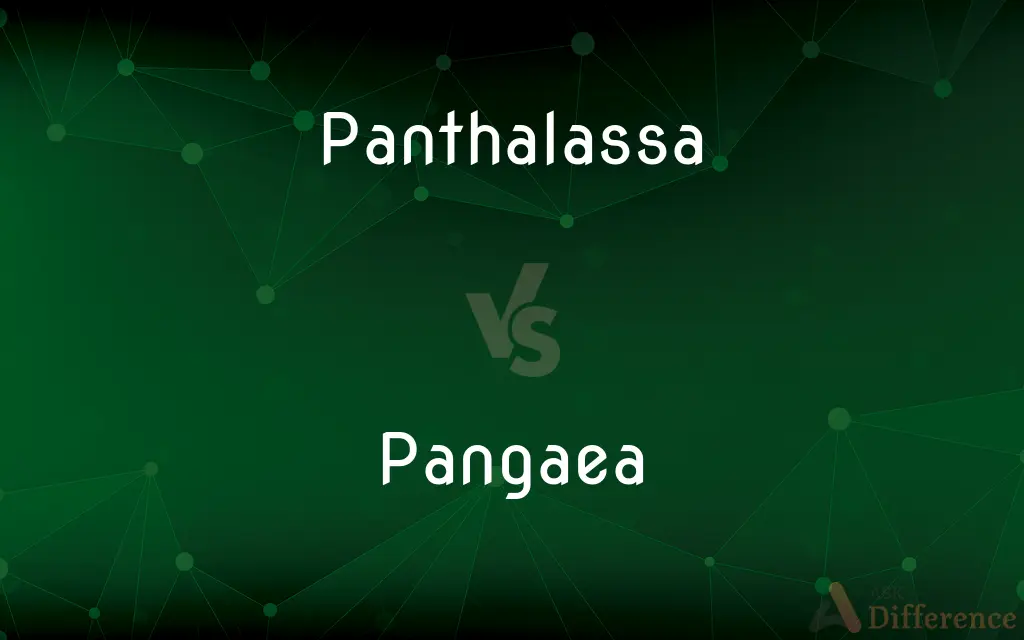Panthalassa vs. Pangaea — What's the Difference?
By Fiza Rafique & Urooj Arif — Updated on April 27, 2024
Panthalassa was the vast global ocean that surrounded the supercontinent Pangaea, which was a single massive landmass that existed during the late Paleozoic and early Mesozoic eras.

Difference Between Panthalassa and Pangaea
Table of Contents
ADVERTISEMENT
Key Differences
Panthalassa, also known as the "universal ocean," encompassed nearly all the Earth's water bodies, surrounding the supercontinent Pangaea, which comprised all the Earth's landmasses consolidated into one.
The existence of Panthalassa and Pangaea highlights the dynamic nature of Earth's surface, governed by plate tectonics; Panthalassa's expansive waters contrast with Pangaea's extensive land.
As Pangaea began to break apart during the Jurassic period, Panthalassa played a crucial role in the formation of newer, smaller oceans, whereas the fragments of Pangaea formed today’s continents.
The environmental conditions of Panthalassa were markedly different from those of the smaller, modern oceans, with possibly more uniform marine conditions, while Pangaea's large landmass featured diverse and extensive ecological zones.
Understanding Panthalassa and Pangaea helps scientists reconstruct ancient climate patterns, oceanic and terrestrial circulation systems, which are crucial for understanding past biodiversity and geological formations.
ADVERTISEMENT
Comparison Chart
Definition
The vast global ocean around Pangaea.
The supercontinent comprising all land.
Existence Period
Paleozoic to Mesozoic eras.
Late Paleozoic to early Mesozoic eras.
Composition
Mostly water.
Entirely land.
Role in Earth's History
Influenced the development of marine life and ocean currents.
Influenced terrestrial life and geological structures.
Impact on Modern Earth
Led to the formation of present-day oceans.
Led to the formation of present-day continents.
Compare with Definitions
Panthalassa
Characterized by its vastness and relatively uniform environmental conditions.
The vast open waters of Panthalassa were devoid of significant land barriers.
Pangaea
A supercontinent that existed during the late Paleozoic and early Mesozoic eras.
Pangaea included all current continents.
Panthalassa
The predecessor to the modern Pacific Ocean.
The remnants of Panthalassa are mostly observed in the deep waters of the current Pacific.
Pangaea
Featured diverse climatic and ecological zones.
Pangaea’s vast size created extreme climatic variations from its center to its coasts.
Panthalassa
An ocean that played a key role in marine evolutionary history.
Many ancient marine species evolved in Panthalassa.
Pangaea
The landmass whose breakup led to the formation of today’s continents.
The breakup of Pangaea resulted in the separation into Laurasia and Gondwana.
Panthalassa
Influential in the breakup of Pangaea.
The tectonic movements beneath Panthalassa contributed to the fragmentation of Pangaea.
Pangaea
Influential in terrestrial biodiversity patterns.
Pangaea’s configuration impacted the dispersal and evolution of many terrestrial species.
Panthalassa
The universal ocean surrounding Pangaea.
Panthalassa covered more than two-thirds of the Earth’s surface.
Pangaea
Central in the study of continental drift and plate tectonics.
The theory of continental drift is largely based on the evidence from Pangaea’s existence.
Panthalassa
Panthalassa, also known as the Panthalassic Ocean or Panthalassan Ocean (from Greek πᾶν "all" and θάλασσα "sea"), was the superocean that surrounded the supercontinent Pangaea, the latest in a series of supercontinents in the history of Earth. During the Paleozoic–Mesozoic transition c.
Pangaea
Pangaea or Pangea ( ) was a supercontinent that existed during the late Paleozoic and early Mesozoic eras. It assembled from earlier continental units approximately 335 million years ago, and began to break apart about 175 million years ago.
Pangaea
A supercontinent that included all the world's landmasses in the late Paleozoic and, according to the theory of plate tectonics, subsequently broke apart into Laurasia and Gondwana.
Pangaea
(plate tectonics) a hypothetical continent including all the landmass of the earth prior to the Triassic period when it split into Laurasia and Gondwanaland
Common Curiosities
What defines the boundaries of Panthalassa?
Panthalassa was bound by the supercontinent Pangaea, meaning its edges were wherever Pangaea’s coastlines were located.
What evidence do scientists use to study Panthalassa?
Evidence includes oceanic crust remnants, sediment samples from deep-sea drilling, and paleoclimatic data.
What caused the breakup of Pangaea?
The breakup was primarily driven by tectonic forces and mantle convection beneath the Earth’s crust.
Was Panthalassa deeper than today’s oceans?
Yes, due to its vast size and the fewer sediment deposits at the time, Panthalassa was likely deeper than current oceans.
How did the fauna in Panthalassa compare to Pangaea’s terrestrial life?
Marine life in Panthalassa was as diverse and complex as terrestrial life on Pangaea, each adapting to their unique environments.
How did Panthalassa’s existence influence ocean currents?
Its vast, unobstructed waters likely allowed for very strong and long-reaching ocean currents.
Can Panthalassa be compared to any modern ocean?
While parts of the modern Pacific Ocean are remnants of Panthalassa, no current ocean matches its size and scope.
How long did Panthalassa exist?
Panthalassa existed for about 300 million years, from the late Paleozoic to the Mesozoic era.
How did life on Pangaea differ from today?
Life on Pangaea was distributed across a contiguous landmass, which allowed for unique evolutionary pathways, distinct from those on separated continents.
What role did Panthalassa play in climate during its time?
The superocean had a significant impact on global climate patterns, likely contributing to more extreme climate conditions on Pangaea.
Did Panthalassa have islands or was it completely open water?
While primarily open water, it’s possible that volcanic islands existed, similar to those in today’s Pacific.
What geological features resulted from the interaction between Panthalassa and Pangaea?
Subduction zones around the edges of Pangaea and mid-ocean ridges in Panthalassa were significant features.
What type of climate did Pangaea have?
Pangaea likely had extremely varied climates, from arid interior deserts to lush coastal regions, due to its massive size and varied topography.
How does the study of Panthalassa help in understanding modern marine biology?
Studying Panthalassa helps scientists understand the evolutionary lineage of many marine species and the historical context of marine biodiversity.
What lessons does the history of Panthalassa and Pangaea offer for current geological studies?
They illustrate the dynamic nature of Earth’s surface and help predict future tectonic activities and their potential impacts on global geography.
Share Your Discovery

Previous Comparison
Confirm vs. Ok
Next Comparison
Honey vs. LoveAuthor Spotlight
Written by
Fiza RafiqueFiza Rafique is a skilled content writer at AskDifference.com, where she meticulously refines and enhances written pieces. Drawing from her vast editorial expertise, Fiza ensures clarity, accuracy, and precision in every article. Passionate about language, she continually seeks to elevate the quality of content for readers worldwide.
Co-written by
Urooj ArifUrooj is a skilled content writer at Ask Difference, known for her exceptional ability to simplify complex topics into engaging and informative content. With a passion for research and a flair for clear, concise writing, she consistently delivers articles that resonate with our diverse audience.
















































